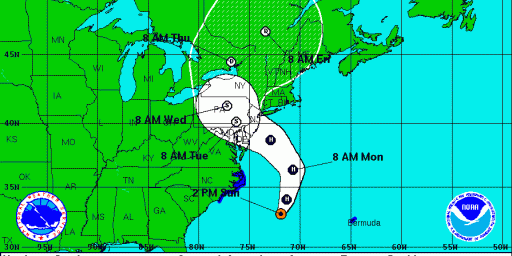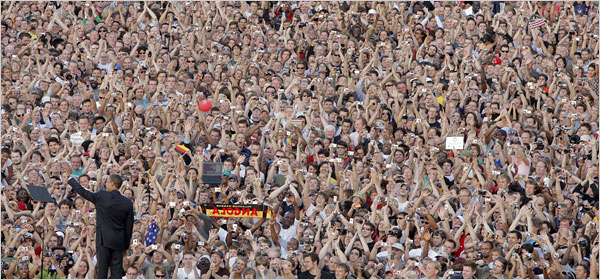Mass Transit: Why Can’t Atlanta be More Like Berlin?
Paul Krugman recently visited Berlin and had an epiphany: It’s different than Atlanta.
To see what I’m talking about, consider where I am at the moment: in a pleasant, middle-class neighborhood consisting mainly of four- or five-story apartment buildings, with easy access to public transit and plenty of local shopping. It’s the kind of neighborhood in which people don’t have to drive a lot, but it’s also a kind of neighborhood that barely exists in America, even in big metropolitan areas. Greater Atlanta has roughly the same population as Greater Berlin — but Berlin is a city of trains, buses and bikes, while Atlanta is a city of cars, cars and cars.
[…]
Public transit, in particular, faces a chicken-and-egg problem: it’s hard to justify transit systems unless there’s sufficient population density, yet it’s hard to persuade people to live in denser neighborhoods unless they come with the advantage of transit access.
And there are, as always in America, the issues of race and class. Despite the gentrification that has taken place in some inner cities, and the plunge in national crime rates to levels not seen in decades, it will be hard to shake the longstanding American association of higher-density living with poverty and personal danger.
Still, if we’re heading for a prolonged era of scarce, expensive oil, Americans will face increasingly strong incentives to start living like Europeans — maybe not today, and maybe not tomorrow, but soon, and for the rest of our lives.
Now, as Mark Finkelstein documents, the same statistics which show a plunge in inner city crime rates also show that the Atlanta suburbs are three times less prone to violent crime than the downtown area. So, maybe there’s something to this perception beyond racism and classism.
While it’s undoubtedly the case that public policy decisions have made it easier for people to live in the suburbs, the assumption that everybody really wants to live in big cities and don’t because of zoning rules and whatnot is unfounded. There are actual reasons to prefer the suburbs. Some people actually like to have backyards. Or to be able to sleep without hearing their neighbor’s stereo, police sirens, or the sounds of nightlife.
But it’s true that there are advantages to density, too. The ability to walk to meet friends and go to restaurants, bars, and the corner grocery store is nice. (Although, to be honest, I’m not sure how often I’d walk to the grocery store, anyway. I like the luxury of grabbing, say, a couple cases of water or other heavy items that weren’t on my list. That’s impractical even if one is a 10-15 minute walk from home.)
Dan Savage and Matt Yglesias are right that we can do better at providing good public transportation for those who want it. Duncan Black suggests that we incorporate mass transit into the planning of development corridors to begin with. That all makes sense.
Inevitably, though, these discussions devolve into “and we need to make it more expensive for people to drive, too!” That’s just counterproductive. Our elected leaders aren’t going to go against the interests of their constituents in that way. Nor should they. We should devote our efforts to making mass transit and compact living more attractive rather than making the alternatives worse.






We have spent 100’s of millions if not billions on public transport in this country, so the issue is not money.
And he might want to check out the square footage of the apartments before deciding that there is no value to the American system. As a test, take figure out how many rooms of your home you could occupy given the sq footage of a Paris or Berlin apartment, then try moving all your stuff into just those rooms and live like that for a week.
The number of factors (size, taxes, demographics, number of children per family, etc) that have led to the difference between US and Europe is much more than just transportation.
I am not sure what specific arguments you are referring to with regard to the devolution.
But, one of the main problems we have with transportation funding is that it is highly inequitable and that people currently DON’T PAY THE REAL COSTS OF DRIVING.
We are highly subsidizing a form of mobility that costs an average of $7,000/annually just to directly use–whereas public transit passes generally cost $62.00 a month.
It makes sense to provide more resources to transit modes that have lower barriers to entry.
If we did this, the cost of driving would undoubtedly rise–compared to the current subsidized levels–but there would be more truth in pricing and public behavior would adjust accordingly.
It is not a matter of “making it more expensive”–rather it is an issue of making people bear the full costs of their actions.
the same statistics which show a plunge in inner city crime rates also show that the Atlanta suburbs are three times less prone to violent crime than the downtown area
Pretty neat trick.
White people flee the inner city because of black people.
Jobs follow white people. Poverty and crime stays.
Black people try to follow jobs. Redlining keeps them put.
White people say they won’t go back to inner city because that’s where all the
black peoplecrime and poverty are.Neat trick, indeed. How does that work, exactly? Are you insinuating that poor black people commit most of the crimes?
Apples, meet oranges.
It’s true that we subsidize driving, in that road construction costs outweigh what we recover in fuel taxes. But we also subsidize, say, Amtrack. And all public transit. You really think the bus or rail pass recovers the fee?
We should look at transit as infrastructure. It’s worth spending money to make sure people and goods can move around efficiently.
A fewobservations:
As noted by yetanotherjohn, the history and society of Europe do differ rather markedly from that of the US. From land ownership practices to tax rates, cities like London, Paris, Rome, and Berlin have strongly encouraged dense housing by making it unaffordable to do otherwise.
I’m sure Krugman realizes that Berlin was bombed and shelled to rubble, right? Starting with a new canvas always makes it easier to correct past problems.
Something I noted in Belfast back in the mid-90s: In trying to settle restive Republicans, the UK gov’t built high rise apartments to get people out of their little, cramped, and fetid houses. For some reason, the Irish don’t like living in highrises. They not only trashed them, but the buildings served as hotbeds of insurrection.
Part of the solution was to get rid of the highrises and build single-family homes. The new homes were row houses, also densely packed together, but the option of living on one or two levels, without someone above or below you, was very popular. It at least solved the problem of people complaining about their housing.
And for the curious, yes, all of the housing (both apartments and houses) was public-subsidy housing, with the highest subsidies in all of Europe.
Andy Vance: You may want to brush up on your history some. ‘Black Flight’ of the cities has been quite successful, at least for those with jobs. The Black middle class has abandoned most urban centers like DC and Baltimore. NYC is a special case.
Berlin also had the advantage of being more or less leveled in 1945.
General Sherman tried to do the same favor for Atlanta 80 years earlier, but did the ungrateful rebels take advantage of the opportunity to implement sounder transit options? Of course not.
Are you insinuating that poor black people commit most of the crimes?
Huh? Are you contenting most of the crime in poor black neighborhoods isn’t committed by poor black people?
No–neither does driving. My point is that we have to recognize mobility as a public good and develop a funding scheme that serves the “public” accordingly and which is efficient in the utilization of scarce resources.
One thing that is missing from Krugman’s piece is that in Europe, land-use regulation is done largely at the national level, making regional transportation coordination easier.
In the US–of course–it is done at the opposite, local, level.
In many places in Europe (London, for example, or Stockholm) and Japan, public transit either runs with minimal subsidy or at a profit through privatization schemes or quasi-public corporations.
It is only profitable because land use policy is coordinated, whereas in the US, it is not. Hence, we waste millions on a sprawling transportation infrastructure to link all of the uncoordinated policies of local governments.
From when I lived in England, I knew many people with civil service jobs that didn’t own cars and relied on public transportation to do everything. Not because they wanted to or out of a Gaia fetish, but because they couldn’t afford to own a car.
As anyone’s standard of living rises, time becomes ever more important to them. The single largest negative impacts for me when it comes to relying on public transportation are time and convenience. The only way you are going to able to change that is to drag my standard of living down to the point where I cannot afford private transportation.
Oh joy!
Percentage of population of DC that is African American =57%
Percentage of population of Baltimore that is African American =65%
You hit the nail on the head–through restrictive zoning suburbs can keep lower-cost housing out, giving people who don’t have access to decent paying jobs little choice in where they live.
The median income in Fairfax COunty VA was $83K in 2000, with a homeownership rate of 71% and a population that is 72% white
DC’s homeowner rate was around 40% and household income was about $43K
Not because of crime, crumbling infrastructures, high taxes, gridlock, hopelessly corrupt governments, dilapidated housing, failing schools, etc., but to get away from black people.
Thanks for the insight.
The U.S. is big enough and rich enough to allow people the choice of public or private transportation. Choice is the core principle of freedom. It’s the American way. There is no logical reason for the government not to provide for both means of transportation. The fact that liberals want to deny Americans choice shows they are fundamentally anti-American in their heart of hearts.
Not because of crime, crumbling infrastructures, high taxes, gridlock, hopelessly corrupt governments, dilapidated housing, failing schools, etc., but to get away from black people.
Cause, meet effect; effect, meet cause. Now don’t you two crazy kids get mixed up.
Most or all of the conditions you cite are *effects* of white flight.
There’s another reason that people fail to consider why the German model may not work well in the United States — scale. How many of you know that the state of Montana is larger than the nation of Germany? California is larger than Montana, Texas is larger than California, Alaska is larger than Texas, the other 46 states are larger than those four, and heaven only knows the size of the additional seven states Obama is talking about. The fact that the U.S. has plenty of liebensraum changes the equation significantly.
That’s OK. I’m sure once Obama’s in the WH, he can arrange for some middle eastern residents to accept the contract for that job.
Suburban living is artificially attractive because it (and its prerequisite, the single-occupant motor vehicle) are incredibly subsidized.
We subsidize mass transit a small amount in comparison. To get anything remotely like an even playing field would require gas taxes of a couple bucks a gallon, and a complete rework of property taxes (as well as city charges for things like water/sewer/electric).
Of course this doesn’t mean the natural preference for suburban living vanishes in a fair environment. Some people live that way in Europe, after all. But comparatively few do, when costs are accurately accounted.
Likewise, if we subsidized bacon so it was a tenth as expensive as it is today, a lot more people would eat bacon a lot more often. It wouldn’t mean I love bacon any more (or less); it would mean I want it at a given price more than the alternatives, but at a different price I might think differently.
The scale of the US is completely irrelevant – most of us live in large metropolitan areas and do our driving to/from work and to/from shopping areas. We don’t spend our weekends driving through Montana. And the population of Europe is roughly comparable to that of the US, in not much less space (you can make them almost match if you take out the states in the US where hardly anybody lives anyways).
(People live in quasi-European settings in New York; even though it’s located on the North American continent, after all).
Had we decided NOT to excessively subsidize suburban sprawl and its prerequisites after WWII, this continent would look a lot like Europe.
Let’s see if I understand. Whites move out and allow the remaining citizens to run society without white interference. Those remaining turn the cities into mini versions of Haiti. How the heck is that the white people’s fault?
I do not agree with that statement Anderson. They may very well exacerbate some of the problems, but they didn’t cause them.
Cities are for the rich, the very poor and young adults. If you look at who moves into the suburbs it is the middle class families to provide a better life for their children. If you are rich, you can afford a big enough piece of the city to get around the strictures of urban life and afford to live close enough to your inner city work for convenience. If you are very poor, you can’t leave the city limits without losing some of the social net. If you are a young single adult or childless couple, you live in the city for the pooling effect.
If you have children, you work long and hard to leave the city to improve your quality of life for the kids, i.e., they have grass and trees in the backyard, better schools and fewer interactions with the criminal element. You move further and further out to avoid the inevitable city expansion to capture more tax base. A tax base most often driven from the cities by increasing taxes to pay for expanding social programs for the poor. Many times this tax base is purposely pushed out to enhance the power of constituency of the local politicians. (See the Curley Effect by Glasaer). Not to mention, freedom. The further out you go, the less interference you get in your ability to have a bbq grill, have a shop for your hobby, grow a garden, or let your kids put together a neighborhood football game.
I fail to see the argument against roads being under charged for. The roads are necessary without commuters and are subsidized by the tax on trucking. They bring supplies and goods into and out of the city. Without them, there is no commerce. If all commuters started taking the train, those roads would have to be paid for somehow. A train, bus or subway system only moves people and will always fall short in supporting physical commerce. Not to mention, subways and trains impose barriers to modern work since they force work to occur on their schedule and not the employers or employees. No working after 7 if you got get that last train out, no running out to deal with a sick child during the workday or school disruption, no working overnight or coming in for a midnight emergency, no coming in on weekends. Commuter trains being more restrictive then a inner suburb subway.
Lots of people find 5,000 sq. ft. homes on 100 acre estates appealing, too. The reason they don’t live on them is economics not raw preference.
In my view we should phase out the subsidies and let the underlying economies make the determinations. Speculating on what people might do or might want without them is futile.
Which subsidies, though? Roads, bridges, sewer lines, and the like are public goods. Are we going to privatize all of that?
Federal subsidies on all of those should go except in the cases of bridges that cross state lines. Will state and local governments make up the difference? I doubt it.
The housing subsidy should be capped.
James, one approach, for instance, would be to change how we charge for those items to more accurately reflect the cost of providing that service. It’s clearly more expensive to build sewer lines for an exurb than for an inner-city neighborhood; yet both pay the same (even though the exurbanites are most likely the rich ones).
You mean to say we had all the advantages of an urban European lifestyle and gave it up to move to the suburbs? THANK GOD!!!
It seems to me that building sewer lines for an exurb would be less expensive than building in the inner city. In the exurb, you can put in sewers faster and easier because you start with a blank slate. In the inner city, you have to work around existing streets, structures, people, and traffic. But if you mean that it would be easier to build a new sewer in an empty area that you intend to become an inner city neighborhood…well, sure. But there are no big empty areas in the inner city that don’t already have sewer systems.
Ignoring politics, and only considering the law of physics and the finite nature of planet Earth’s surface area suitable for occupation, people have to:
[1] Congregate in densely populated areas, to free up the maximum area for agriculture, etc.
[2] Install electrified rail based transportation.
{lower coefficient of rolling resistance, lower fuel consumption, durability, etc.}
Implementing #1, makes the point to point limitation of #2 rail less of a problem.
Using politics to bypass the law of physics and nature will not succeed.
Wise folks will bail out of automobile-bound suburbia, within the next 5 years, as fuel costs make it less viable.
On the chopping block –
SUV today, Suburbia tomorrow.